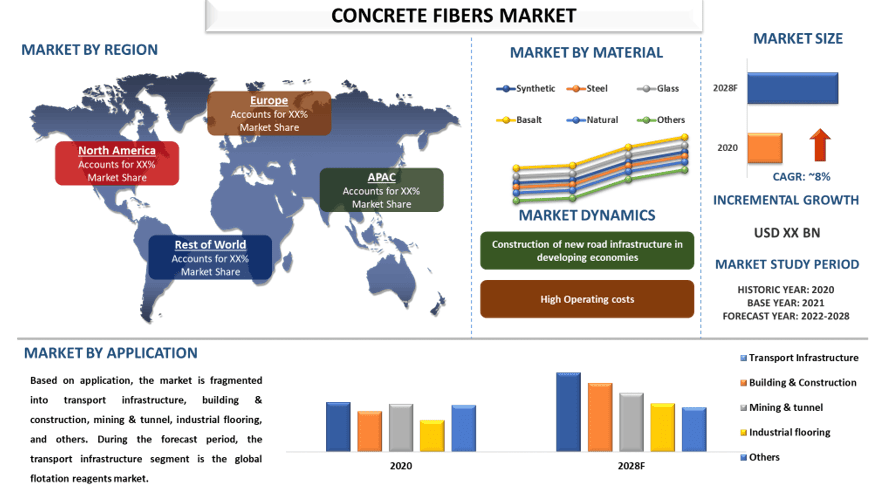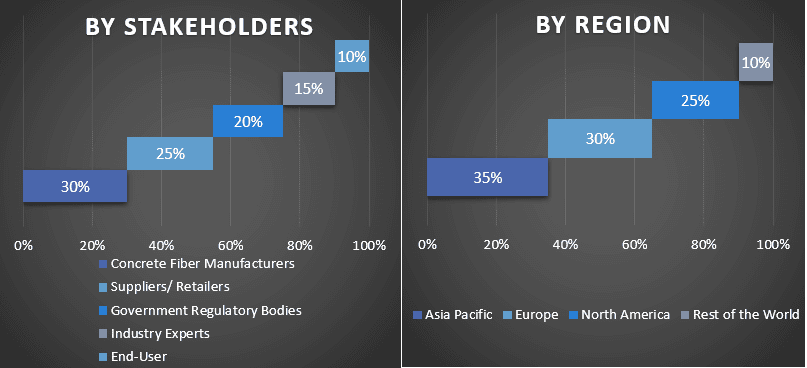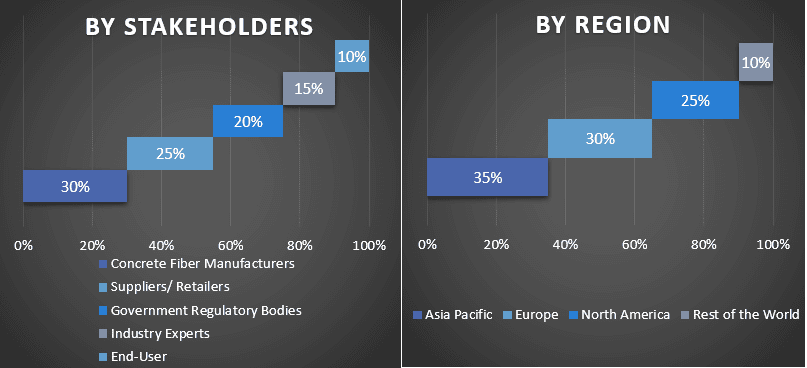Emphasis on Fiber type (synthetic, steel, glass, basalt, natural, others); End-User (transport infrastructure, building & construction, mining & tunnel, industrial flooring, others); and Region/Country

The Concrete Fibers market is expected to witness a CAGR of around 8% during the forecast period (2022–2028). As the market is anticipated to witness owing to growth in the construction industry. For instance, in the year 2020, more than 2,500 worldwide infrastructure projects were proclaimed which was a rise of 5.5 percent from 2019. More than half of these were classified as sustainable infrastructure projects, such as solar and wind power. Such factors are projected to drive the market growth of concrete fiber over the years. Owing to the growth in construction sites such as roads, building and others are propelling the growth of the concrete fibers market globally.
In addition, major players such as N.V. Bekaert S.A, Propex Operating Company LLC, Sika AG, ABC Polymer Industries LLC, Cemex S.A.B. De C.V., BASF SE, The Euclid Chemical Company, Owens Corning GCP Applied Technologies, and Nycon Corporation. Several M&As along with partnerships have been undertaken by these players to develop the concrete fibers market.
Concrete fibers or fiber-reinforced concrete (FRC) is concrete containing fibrous material which increases its structural integrity. It contains short discrete fibers that are uniformly distributed and randomly oriented. In addition, the varieties of fiber-reinforced concrete change with varying concretes, fiber materials, geometries, distribution, orientation, and densities. In addition, concrete fiber is used in mining and tunnel applications for improving concrete strength and durability, shock & fatigue resistance, and other characteristics. Moreover, they are used in tunnel linings and subways to redistribute the forces within the concrete structure. Furthermore, the increasing demand for minerals and mining metals has surged the mining activities where concrete fiber is widely used to resist crack formation in concrete structures.
However, COVID–19 has devasted the global economy due to which many sectors experienced a downfall as the demand for concrete fibers got reduced within the industries because of their shutdowns. The delay in construction project deadlines got delayed due to a decline in the construction sector. However, the industries have been in process for a certain period, and the usage of concrete fibers is increasing as a result of work on construction sites. In addition, the production of roadways, highways, expressways, airports, parking areas, mining, and tunnels, dams, water tanks, waterways, elevated decks, dock areas, and recreation require concrete fibers, by which the growth of the concrete fibers market will be seen during the forecasted period.
Insights Presented in the Report
“Amongst fiber type, steel category to hold a significant share in the market”
Based on fiber type, the market is fragmented into synthetic, steel, glass, basalt, natural, and others. During the forecast period, the steel segment is likely to dominate the global concrete fibers market. The steel concrete fiber leads the market owing to its exceptional properties, such as shock & fatigue resistance, remarkable tensile & flexural strength, sturdiness, and ductility. In addition, steel fiber reinforced concrete is best suited for controlling cracks that occur at an early stage of construction and crack control during enhanced load-bearing situations. Furthermore, the factors justify its use in the market which will drive its growth during the forecasted period.
“Amongst end-user, standby to hold a significant share in the market”
Based on end-user, the market is fragmented into transport infrastructure, building & construction, mining & tunnel, industrial flooring, and others. In 2020, the transport infrastructure segment is seen dominating the growth of the concrete fibers market. In the transport industry concrete fibers are extensively employed to construct highways, roads, railways, bridges, and ports & airports. Also, many emerging countries are now shifting their focus towards concrete fibers for construction purposes. For instance, in Jun 2021, Sika AG launched a new concrete reinforcing fiber solution SikaFiber-1050 B&BA HF, which is used to enhance concrete topping durability, reduce shrinkage cracking, and can be used for block and beam floors.
APAC to witness significant growth during the forecast period”
Asia-Pacific is likely going to dominate the concrete fibers market during the forecasted period. As the increasing population has surged the growth of residential building and construction activities, which will further propel the growth rate of the concrete fiber market. Furthermore, rapid industrialization has accelerated the establishment of industries in both developed and developing economies in which concrete fiber is used to improve the tensile strength of industrial structures. In addition, China has boosted its road development and maintenance expenditures. For instance, according to data released by China’s Ministry of Transport, road construction increased by 13.8% between January 2021 and June 2021 compared to the same period in 2020. Furthermore, in 2021 the Alberta government has increased its investments in highway and water management infrastructure to improve highway safety, link communities, and keep Albertans employed. The projects will improve traffic safety, support significant commerce routes to promote commercial carrier travel and offer irrigation and flood mitigation protection for Alberta towns. Moreover, in 2022, India’s road industry will experience enormous growth as additional stretches of national roads are built, and several projects and fundraises are granted and completed, making it a better year during the forecasted period.
Reasons to buy this report:
Customization Options:
The Concrete Fibers Market can further be customized as per the requirement or any other market segment. Besides this, UMI understands that you may have your own business needs, hence feel free to connect with us to get a report that completely suits your requirements.
1. Market Introduction
2. Research Methodology Or Assumption
3. Market Synopsis
4. Executive Summary
5. Global Concrete Fibers Market Covid-19 Impact
6. Global Concrete Fibers Market Revenue (usd Bn), 2020-2028f
7. Market Insights By Fibre Type
8. Market Insights By End-user
9. Market Insights By Region
10. Concrete Fiber Market Dynamics
11. Concrete Fiber Market Opportunities
12. Concrete Fiber Market Trends
13. Value Chain Analysis
14. Competitive Scenario
15. Company Profiled
16. Disclaimer
Research Methodology for the Concrete Fibers Market Analysis (2022-2028)
Analyzing the historical market, estimating the current market, and forecasting the future market of the concrete fibers market were the three major steps undertaken to create and analyze the adoption of concrete fibers in major regions globally. Exhaustive secondary research was conducted to collect the historical market numbers and estimate the current market size. Secondly, to validate these insights, numerous findings and assumptions were taken into consideration. Moreover, exhaustive primary interviews were also conducted, with industry experts across the value chain of the concrete fibers market. Post assumption and validation of market numbers through primary interviews, we employed a top-down/bottom-up approach to forecasting the complete market size. Thereafter, market breakdown and data triangulation methods were adopted to estimate and analyze the market size of segments and sub-segments of the industry pertains to. Detailed methodology is explained below:
Analysis of Historical Market Size
Step 1: In-Depth Study of Secondary Sources:
Detail secondary study was conducted to obtain the historical market size of the concrete fibers market through company internal sources such as annual reports & financial statements, performance presentations, press releases, etc., and external sources including journals, news & articles, government publications, competitor publications, sector reports, third-party database, and other credible publications.
Step 2: Market Segmentation:
After obtaining the historical market size of the concrete fibers market, we conducted a detailed secondary analysis to gather historical market insights and share for different segments & sub-segments for major regions. Major segments included in the report as fiber type and end-user. Further country-level analyses were conducted to evaluate the overall adoption of testing models in that region.
Step 3: Factor Analysis:
After acquiring the historical market size of different segments and sub-segments, we conducted a detailed factor analysis to estimate the current market size of the concrete fibers market. Further, we conducted factor analysis using dependent and independent variables such as various fiber types and end-user of concrete fibers equipment. A thorough analysis was conducted for demand and supply-side scenarios considering top partnerships, mergers and acquisitions, business expansion, and product launches in the concrete fibers market sector across the globe.
Current Market Size Estimate & Forecast
Current Market Sizing: Based on actionable insights from the above 3 steps, we arrived at the current market size, key players in the concrete fibers market, and market shares of the segments. All the required percentage shares split, and market breakdowns were determined using the above-mentioned secondary approach and were verified through primary interviews.
Estimation & Forecasting: For market estimation and forecast, weights were assigned to different factors including drivers & trends, restraints, and opportunities available for the stakeholders. After analyzing these factors, relevant forecasting techniques i.e., top-down/bottom-up approach were applied to arrive at the market forecast for 2028 for different segments and sub-segments across the major markets globally. The research methodology adopted to estimate the market size encompasses:
Market Size and Share Validation
Primary Research: In-depth interviews were conducted with the Key Opinion Leaders (KOLs) including Top Level Executives (CXO/VPs, Sales Head, Marketing Head, Operational Head, Regional Head, Country Head, etc.) across major regions. Primary research findings were then summarized, and statistical analysis was performed to prove the stated hypothesis. Inputs from primary research were consolidated with secondary findings, hence turning information into actionable insights.
Split of Primary Participants in Different Regions

Market Engineering
The data triangulation technique was employed to complete the overall market estimation and to arrive at a precise statistical number for each segment and sub-segment of the concrete fibers market. Data was split into several segments & sub-segments post studying various parameters and trends in the areas of various fiber types and end-user in the concrete fibers market.
The main objective of the Concrete Fibers Market Study
The current & future market trends other than the concrete fibers market were pinpointed in the study. Investors can gain strategic insights to base their discretion for investment on the qualitative and quantitative analysis performed in the study. Current and future market trends determined the overall attractiveness of the market at a regional level, providing a platform for the industrial participant to exploit the untapped market to benefit from a first-mover advantage. Other quantitative goals of the studies include:

Customers who bought this item also bought